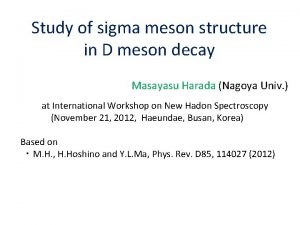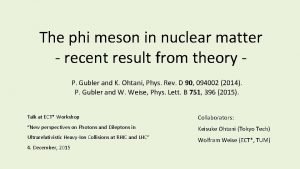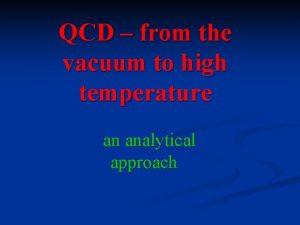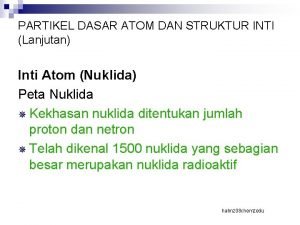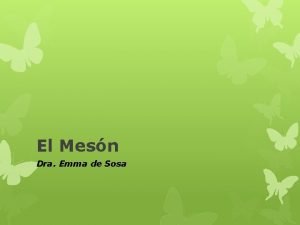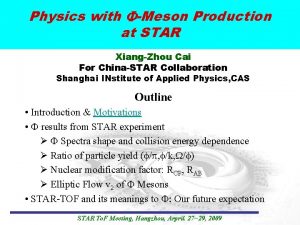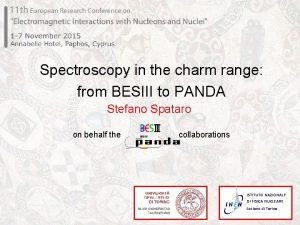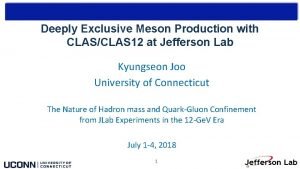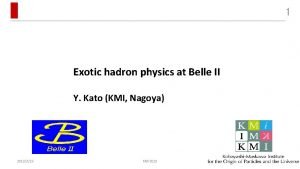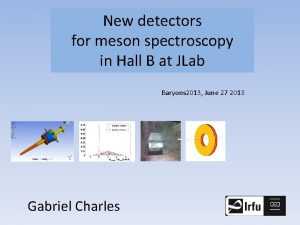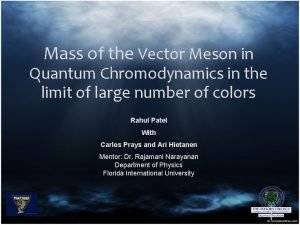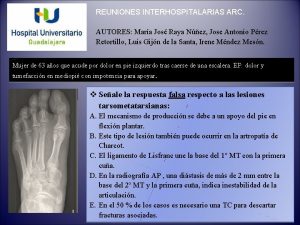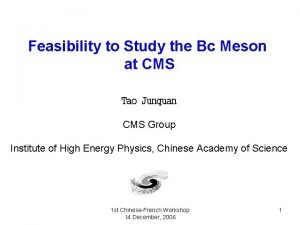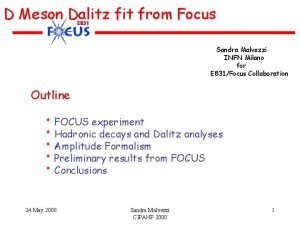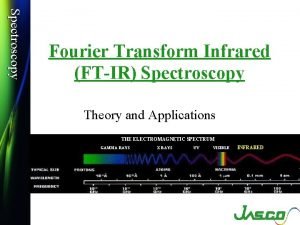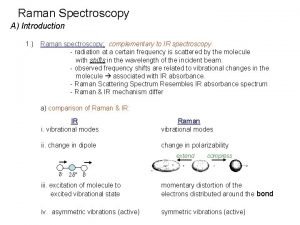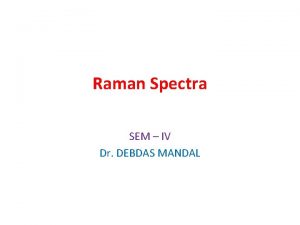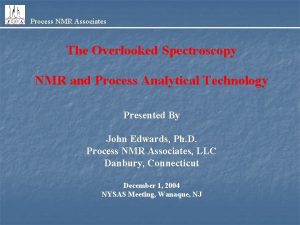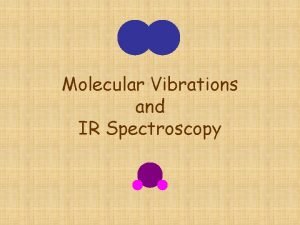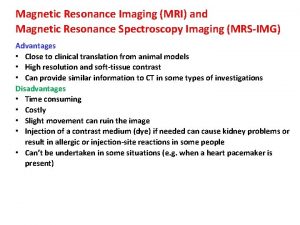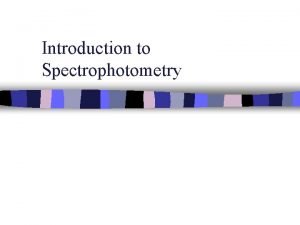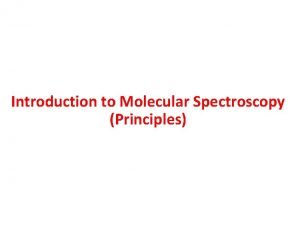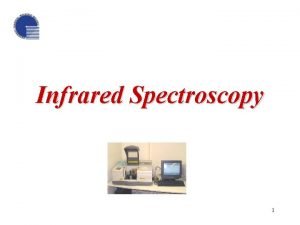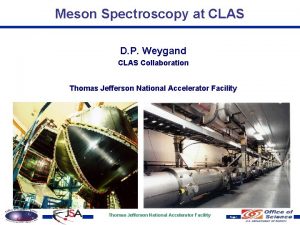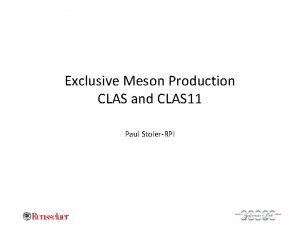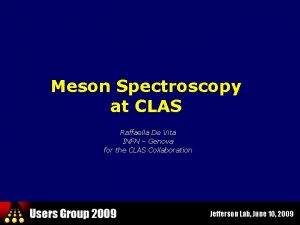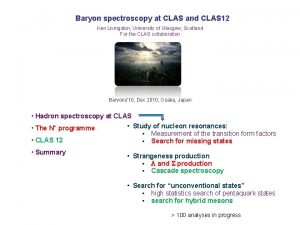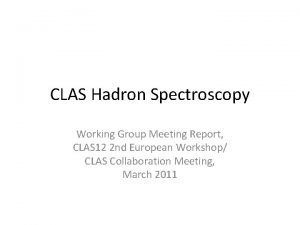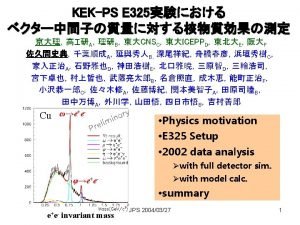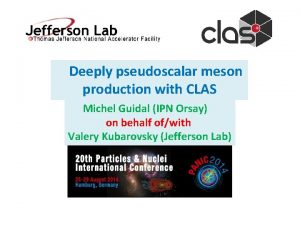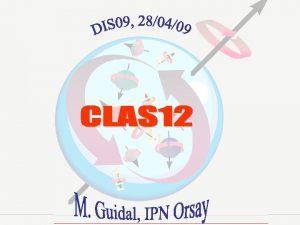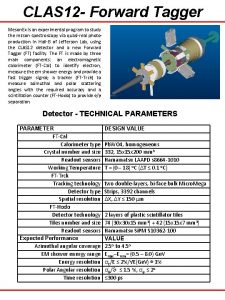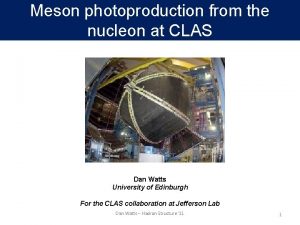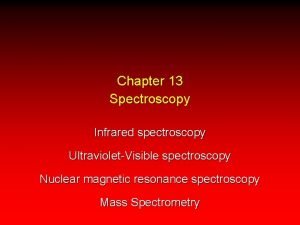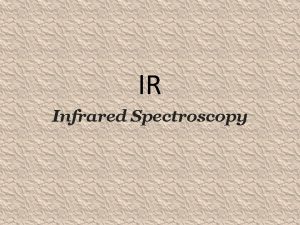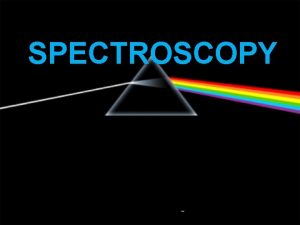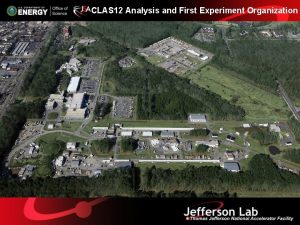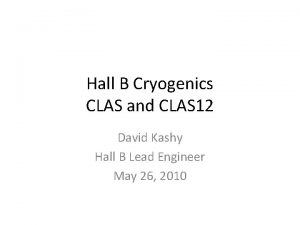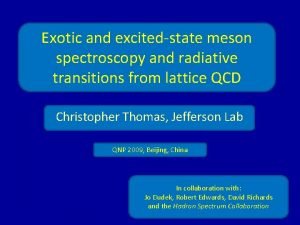Meson Spectroscopy at CLAS and CLAS 12 Carlos























- Slides: 23

Meson Spectroscopy at CLAS and CLAS 12 Carlos Salgado Norfolk State University and Jefferson Lab for the CLAS Collaboration BARYONS - 2010 December 8, 2010 Osaka, Japan C. Salgado, NSU and JLab Meson Spectroscopy at CLAS and CLAS 12 BARYONS 2010, OSAKA, DECEMBER 8, 2010

outline • Motivation: QCD and Meson Spectroscopy (M. S. ) • Current M. S. : Jefferson Lab - CLAS 6 – g 6 c, g 12 and eg 6 experiments • Future M. S. : CLAS 12 - JLab/Hall B at 11 Ge. V – Very low Q 2 (experiments with “quasi-real” photons) – Forward Tagger Detector – Meson Spectroscopy at CLAS 12 C. Salgado, NSU and JLab Meson Spectroscopy at CLAS and CLAS 12 BARYONS 2010, OSAKA, DECEMBER 8, 2010

Why Meson Spectroscopy? • QCD is very well established at high energies • However: PQCD could not calculate observables at lower energies • Until recently…. . now Lattice QCD is providing a spectrum of light mesons! • A better experimental determination of the hadrons' spectrum will provide: - Identification of the relevant degrees of freedom - Study the properties of confinement - A validation for LQCD predictions - A window into the nature of the hadronic mass • Meson spectroscopy is a key tool to investigate these issues C. Salgado, NSU and JLab Meson Spectroscopy at CLAS and CLAS 12 Effective Degrees of Freedom at intermediate energies 0. 1 – 1 fm BARYONS 2010, OSAKA, DECEMBER 8, 2010

Two of today’s most relevant topics in M. S. : 1) Search for Hybrid Mesons Search for non-standard (exotic quantum numbers) states with explicit gluonic degrees of freedom q q • Still some disagreement but : Exotic mesons have been observed at JPC=1 -+ 1400 and 1600 2015 Me. V but are they hybrids? • Need to explore other production mechanism: photoproduction • Validate LQCD predictions 2) Study of Strangeonia • Intermediate states between light and heavy mesons (a bridge to PQCD? ). • Of about 22 resonances expected below a mass of 2. 5 Ge. V, only 7 are “relatively” well established. • Strangeonia hybrids have been predicted just above a mass of 2 Ge. V. C. Salgado, NSU and JLab Meson Spectroscopy at CLAS and CLAS 12 BARYONS 2010, OSAKA, DECEMBER 8, 2010

Experimental challenges in M. S. To determine that a resonance has been produced and to determine resonance’s quantum numbers (J, P and C) and properties (mass, width, cross sections). • • • Study of several decay channels of same resonance Large acceptance detector High event statistics High beam energies: : open the phase space between mesons and baryons Good final state particle resolution and identification Or a Good understanding of resolution and acceptance Quantum number determination : : angular distribution of final states : : Partial Wave Analysis (PWA) PWA techniques with few model dependent assumptions Fast code to perform PWA (computer power) Polarization allows to study the production mechanisms ……. CLAS and CLAS 12 GLUEX COMPASS PANDA BESS-III …. . C. Salgado, NSU and JLab Meson Spectroscopy at CLAS and CLAS 12 BARYONS 2010, OSAKA, DECEMBER 8, 2010

CLAS: CEBAF Large Acceptance Spectrometer Torus Magnet 6 Superconductive Coils Electromagnetic Calorimeter lead/plastic scintillator, 1296 PMTs Target + start counter Drift Chamber 35, 000 cells C. Salgado, NSU and JLab Cherenkov Counter Time of Flight e/ separation, 256 PMTs Plastic Scintillator, Meson Spectroscopy at CLAS and CLAS 12 BARYONS 2010, OSAKA, 684 PMTs DECEMBER 8, 2010

Photoproduction at CLAS Hall-B Photon Tagger • Photon beam produced from the primary electron beam via Bremsstrahlung • Gold and diamond radiator for In/Coherent Bremsstrahlung • Energy coverage: 0. 2 -0. 95 Ebeam • Efficiency ~ 80% • Energy Resolution ~ 10 -3 • Timing Resolution ~100 ps Maximum photon energy of 5. 75 Ge. V - Wmax 3. 4 Ge. V - Mmax 2. 5 Ge. V Beam intensity 107 /s C. Salgado, NSU and JLab Meson Spectroscopy at CLAS and CLAS 12 BARYONS 2010, OSAKA, DECEMBER 8, 2010

Partial Wave Analysis at CLAS (in a slide) ISOBAR MODEL Fitted parameters (production amplitudes) M, t Maximize “Extended” Likelihood or where C. Salgado, NSU and JLab Meson Spectroscopy at CLAS and CLAS 12 Normalization integral BARYONS 2010, OSAKA, DECEMBER 8, 2010

G 6 c (2001 CLAS run) Unpolarised 4. 8 -5. 2 Ge. V photon beam p (n) 1 < 13. 5 nb Clear evidence of non-exotic 2++ state a 2(1320) No-evidence of exotic 1 -+ state 1(1600) at the expected yield C. Salgado, NSU and JLab Meson Spectroscopy at CLAS and CLAS 12 BARYONS 2010, OSAKA, DECEMBER 8, 2010

CLAS photon run up to 5. 5 Ge. V photons: g 12 (10 x more statistics than g 6 c) Search for new forms of hadronic matter in photoproduction • Data taking completed in 2008 • Photon Energy up to 5. 5 Ge. V • More than 26 billion triggers (2 -prong + 3 -prong) • Total Luminosity: 68 pb-1 • Data processing completed and physics analysis in progress Several exclusive channels are being analyzed p p p . . . C. Salgado, NSU and JLab (n) K+K+ (1530) p. K+K- ( ) p ( ) K K (n) e e p Meson Spectroscopy • Search for exotic mesons • Study of Strangeonia • … Baryon Spectroscopy • Cascades • Pentaquarks • … Meson Spectroscopy at CLAS and CLAS 12 BARYONS 2010, OSAKA, DECEMBER 8, 2010

Search for π1 (1400) Diane Schott thesis Florida International U. is reconstructed by the 2 or from missing mass ry a in ry a n lim e Pr i lim e Pr C. Salgado, NSU and JLab Meson Spectroscopy at CLAS and CLAS 12 BARYONS 2010, OSAKA, DECEMBER 8, 2010

Search for π1 (1600) Craig Bookwalter thesis Florida State U. ry a in im l e Pr y r a in m li re P C. Salgado, NSU and JLab Meson Spectroscopy at CLAS and CLAS 12 BARYONS 2010, OSAKA, DECEMBER 8, 2010

Study of Strangeonia Φ im l re P Is there Φ (1600)? C. Salgado, NSU and JLab Meson Spectroscopy at CLAS and CLAS 12 ry a in PWA ready to start BARYONS 2010, OSAKA, DECEMBER 8, 2010

o i m li y r a n e Pr ry a in im l e Pr also M. Saini thesis Florida State U. Look for ηΦ final state ry a in im el r P Φ ηΦ mass - Φ (1600)? i m i l y r na - Φ (1850)? e Pr C. Salgado, NSU and JLab Meson Spectroscopy at CLAS and CLAS 12 PWA ready to start BARYONS 2010, OSAKA, DECEMBER 8, 2010

eg 6: Meson Spectroscopy in coherent production on 4 He search for exotics in η and η’ final states - 1 (1400) RTPC based on cylindrical GEMs for detection of low energy (few Me. V) -particles • 6 Ge. V electron beam on high pressure (6 atm) 4 He gas target • All neutrals trigger • recoiling nucleus detected in Radial TPC • hadronic final state detected in CLAS • PWA greatly simplify: C=-1 and NPE only allowed ( exchange) • No baryon background STATUS • data taking completed in fall 2009 • Reconstruction of data in progress C. Salgado, NSU and JLab Calibration of RTPC using elastic scattering on 4 He at 1. 2 Ge. V Meson Spectroscopy at CLAS and CLAS 12 BARYONS 2010, OSAKA, DECEMBER 8, 2010

JLab Upgrade to 12 Ge. V C. Salgado, NSU and JLab Meson Spectroscopy at CLAS and CLAS 12 BARYONS 2010, OSAKA, DECEMBER 8, 2010

CLAS 12 Forward Detector: - TORUS magnet Forward SVT tracker HT Cherenkov Counter Drift chamber system LT Cherenkov Counter Forward To. F System Preshower calorimeter E. M. calorimeter (EC) Central Detector: - SOLENOID magnet - Barrel Silicon Tracker - Central Time-of-Flight Proposed upgrades: - Micromegas (CD) Neutron detector (CD) RICH detector (FD) Forward Tagger (FD) C. Salgado, NSU and JLab Meson Spectroscopy at CLAS and CLAS 12 BARYONS 2010, OSAKA, DECEMBER 8, 2010

CLAS 12 – Design Parameters L=1035 cm-2 s-1 C. Salgado, NSU and JLab Forward Detector Angular range Tracks 50 – 400 Photons 2. 50 – 400 Resolution � p/p (%) < 1 @ 5 Ge. V/c � (mr) < 1 � (mr) < 3 Photon detection Energy (Me. V) >150 � (mr) 4 @ 1 Ge. V Neutron detection Neff < 0. 7 (EC+PCAL) Particle ID e/ �Full range � p�< 5 Ge. V/c � /K < 2. 5 Ge. V/c K/p� Ge. V/c � �Full range � �Full range Meson Spectroscopy at CLAS and CLAS 12 Central Detector 350 – 1250 --< 5 @ 1. 5 Ge. V/c < 10 - 20 < 5 ----under development --< 1. 25 Ge. V/c < 0. 65 Ge. V/c < 1. 0 Ge. V/c ----- BARYONS 2010, OSAKA, DECEMBER 8, 2010

Hadron Spectroscopy with CLAS 12 using quasi-real photons (Electroproduction at very low Q 2) Experiments using unpolarized leptons are equivalent in the small Q 2 limit to those using partially linearly polarized photons {Dombey 69} • Measured electron scattering at very low forward angles • low-Q 2 virtual photon real photon (well known technique from high energy experiments) • detection of the scattered electron allows to determine the photon energy and linear polarization • Linear polarization is essential to isolate exchange production mechanisms • high luminosity allows the use of thin (gas)- targets C. Salgado, NSU and JLab Meson Spectroscopy at CLAS and CLAS 12 BARYONS 2010, OSAKA, DECEMBER 8, 2010

Forward Photon Tagger for CLAS 12 Quasi-real photons will be “tagged” by detection of scattered electrons at low forward angles High-Threshold Cerenkov Counter Forward Electromagnetic Calorimeter Drift Chambers • electron beam on target, scattered electrons at small angles are detected by the forward detector • hadronic final states are “simultaneously” detected in CLAS 12 • photon linear polarization ~ 65% - 20% is measured event-by-event Central Detector Forward Tagger Torus Magnet Forward Time of Flight • “photon” beam intensity of about 5 x 107 photons/sec C. Salgado, NSU and JLab Meson Spectroscopy at CLAS and CLAS 12 Preshower Calorimeter BARYONS 2010, OSAKA, DECEMBER 8, 2010

Forward Tagger Detectors Electron detection via a system of Calorimeter +Tracker + Hodoscopes for determination of energy and angles • calorimeter to determine the electron energy with few % accuracy • tracker/hodoscope to determine precisely the electron scattering plane and the photon polarization Pb. WO 4 Calorimeter 424 Crystals CLAS IC C. Salgado, NSU and JLab Calorimeter: • homogenous crystals (Pb. W 04) Tracker: • gems, micromegas, Hodoscopes: • Scintillators/MPPC Meson Spectroscopy at CLAS and CLAS 12 BARYONS 2010, OSAKA, DECEMBER 8, 2010

GEANT 4 Beam Forward Tagger CALORIMETER TARGET CLAS 12 Forward Tagger TRACKER Beam MECHANICAL SUPPORT C. Salgado, NSU and JLab SHIELD HODOSCOPE Meson Spectroscopy at CLAS and CLAS 12 BARYONS 2010, OSAKA, DECEMBER 8, 2010

Summary Meson Spectroscopy/LQCD can provide a window into detail studies of strong interactions at intermediate energies At the current CLAS 6 • High statistics data have been taken on photoproduction • First PWA has already been published (in small data set) • PWA currently progressing in several channels (g 12 and eg 6 data) • First results on high statistics PWA will be available very soon The future at CLAS 12 • A Hadron Spectroscopy program is being planned for CLAS 12 using a beam of “quasi-real” photons • An electron tagger system is being designed to detect scattered electrons down to 2 degrees in forward angles • A high intensity (quasi)-real photon beam (including knowledge of the beam polarization) on proton and nuclear targets will create a meson (and baryon) spectroscopy program complementary and competitive with other planned world facilities • A proposal has been submitted to PAC 37 (January 2011) C. Salgado, NSU and JLab Meson Spectroscopy at CLAS and CLAS 12 BARYONS 2010, OSAKA, DECEMBER 8, 2010
 Lean meson
Lean meson Phi meson
Phi meson Meson valves
Meson valves Partikel meson
Partikel meson Mesón de emma
Mesón de emma K star meson
K star meson Charm
Charm Clasclas
Clasclas B meson decay
B meson decay Meson
Meson Meson
Meson Irene mendez meson
Irene mendez meson Mumu+
Mumu+ Sandra malvezzi
Sandra malvezzi Terahertz spectroscopy principles and applications
Terahertz spectroscopy principles and applications Ir spectroscopy definition
Ir spectroscopy definition Why are raman and ir complementary
Why are raman and ir complementary Difference between ir and raman spectroscopy
Difference between ir and raman spectroscopy Nmr associates
Nmr associates Stretching and bending vibrations in ir spectroscopy
Stretching and bending vibrations in ir spectroscopy Advantages of nmr spectroscopy
Advantages of nmr spectroscopy Spectroscopy and spectrophotometry
Spectroscopy and spectrophotometry Application of uv visible spectroscopy
Application of uv visible spectroscopy Advantages and disadvantages of spectroscopy
Advantages and disadvantages of spectroscopy
